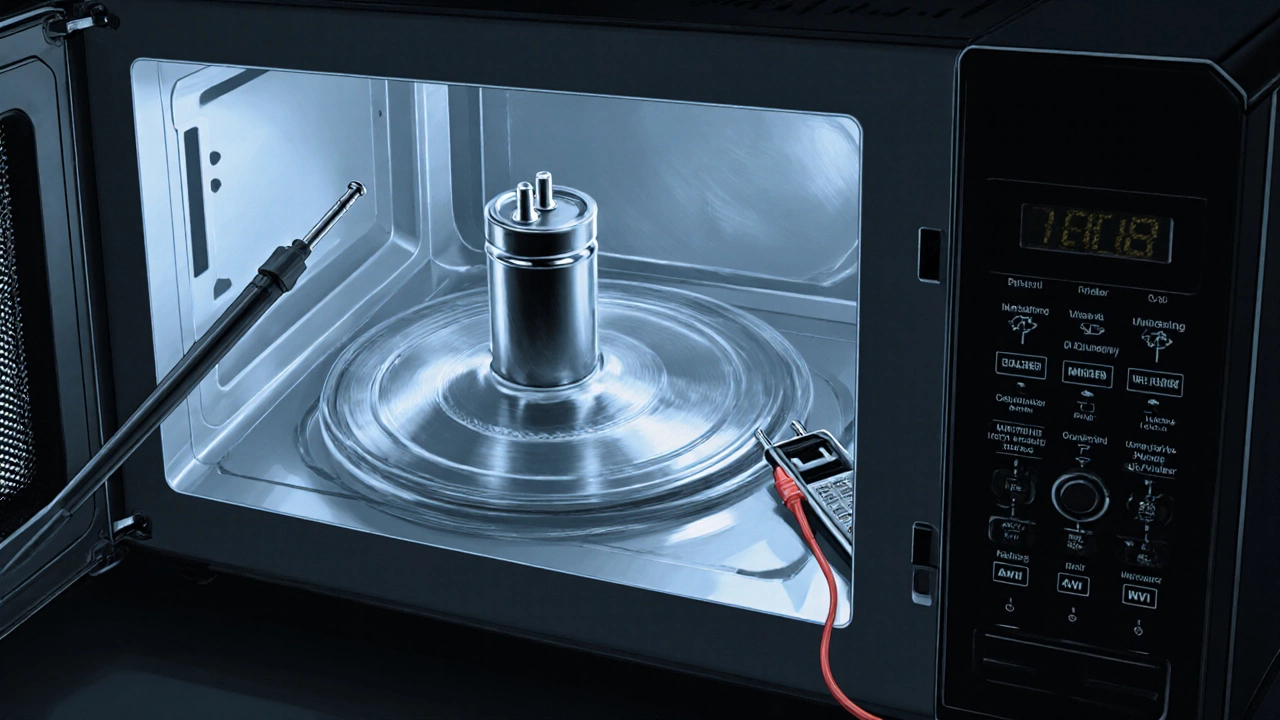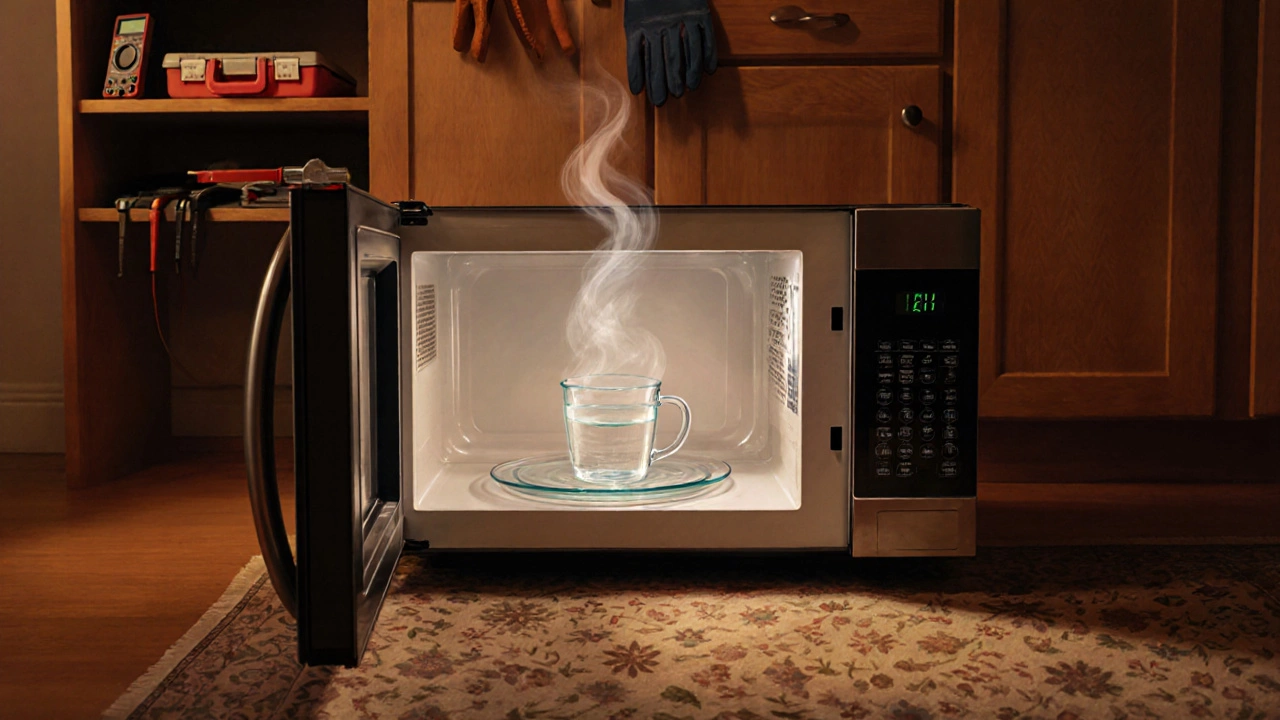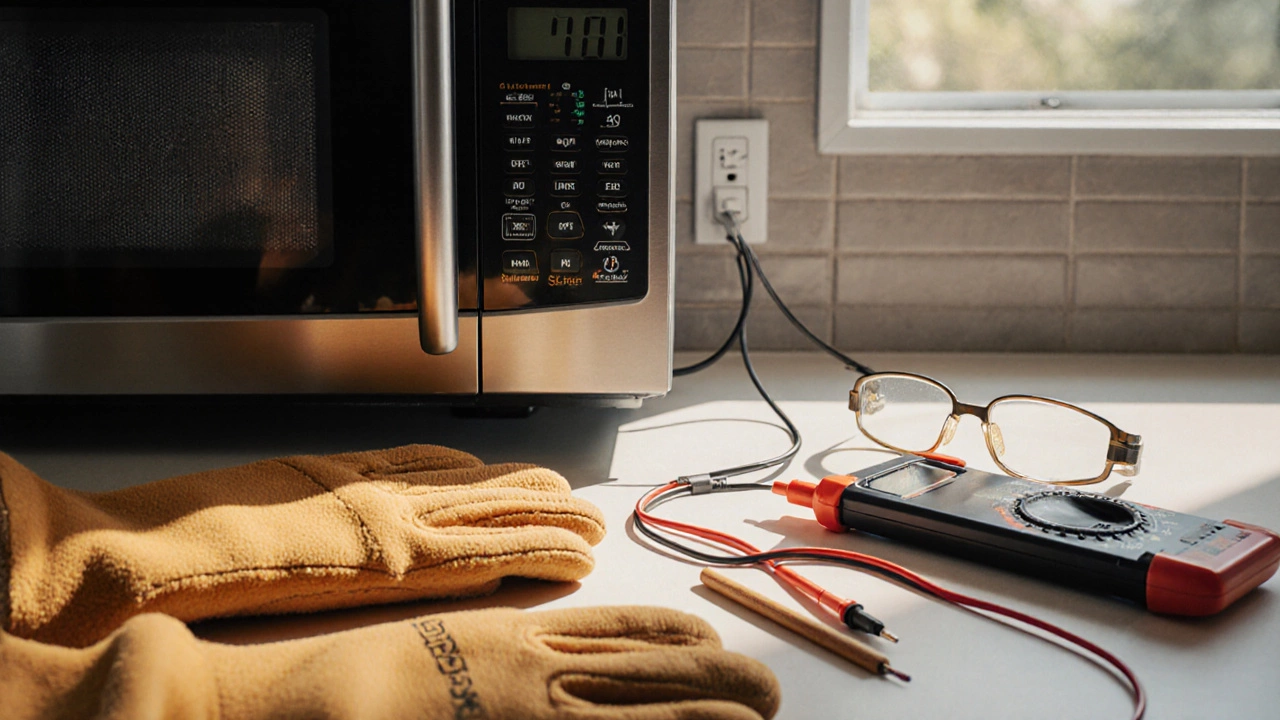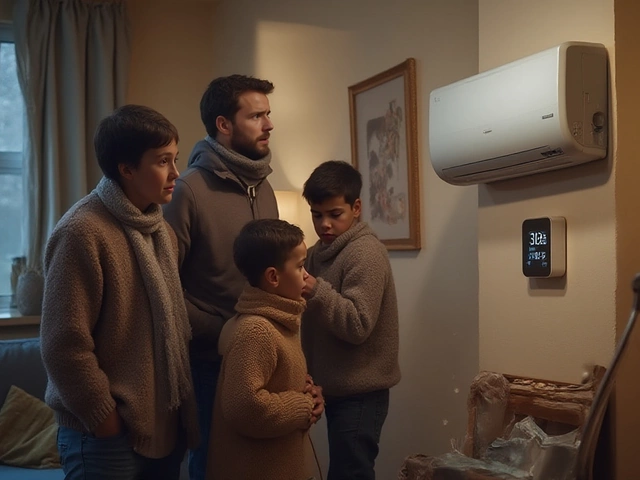When your microwave stops heating, makes strange noises, or refuses to turn on, it’s tempting to call a technician right away. But many of the most common faults can be tackled safely in your own kitchen with a few tools, a bit of patience, and the right guidance.
Key Takeaways
- Always unplug the unit before inspecting any internal component.
- The magnetron, high voltage capacitor, and door interlock are the usual suspects.
- Basic tools - screwdriver set, multimeter, and a replacement fuse - solve 70% of everyday glitches.
- If you see burnt smells, arcing, or water inside the cavity, stop and call a professional.
- Regular cleaning of the waveguide and turntable motor extends the life of your appliance.
Safety First: Power Off, Ground Down
Before you touch any circuit board or metal part, unplug the microwave and wait at least five minutes. The high‑voltage capacitor can store a charge long after the unit is off, and a stray discharge can cause serious injury. Use a non‑conductive tool (like a wooden stick) to verify that the power cord is fully disconnected.
Understanding the Core Components
Microwave Oven is a kitchen appliance that uses electromagnetic radiation to heat food quickly. Inside the cabinet, a magnetron generates microwaves, while a high voltage capacitor stores the burst of energy needed to power the magnetron. The door interlock switch ensures the microwave stops as soon as the door opens, preventing radiation leaks. A thermal fuse protects the unit from overheating, and the control board interprets button presses and regulates power output. Finally, the turntable motor keeps food rotating for even heating.

Common Issues and What They Look Like
| Problem | Symptom | Probable Cause | DIY Fix |
|---|---|---|---|
| Microwave won’t heat | Food stays cold, but timer runs | Faulty magnetron or capacitor | Test with multimeter, replace defective part |
| Turntable doesn’t spin | Plate stays still, humming noise | Broken turntable motor or obstructed gear | Inspect motor, clear debris, replace motor if burnt |
| Microwave shuts off mid‑cycle | Cooking stops abruptly, display blanks | Thermal fuse tripped or door latch loose | Check fuse continuity, reseat door latch |
| Strange sparks or arcing | Flashing light inside cavity, metallic smell | Damaged waveguide cover or metal utensil left inside | Replace waveguide cover, remove metal objects |
| No power at all | Nothing turns on, no lights or sounds | Tripped circuit breaker or faulty power cord | Reset breaker, test cord with voltmeter |
Tools You’ll Need
- Flat‑head and Phillips screwdrivers (set of sizes)
- Multimeter (digital preferred)
- Nut drivers or socket set for inner screws
- Replacement parts: magnetron, capacitor, door interlock, thermal fuse, turntable motor
- Safety gloves and safety glasses
Step‑by‑Step Fixes
1. Microwave Won’t Heat
- Remove the outer cabinet screws (usually hidden behind the base panel).
- Locate the magnetron (large metal tube) and the high voltage capacitor (cylindrical component near the magnetron).
- Discharge the capacitor by shorting its terminals with an insulated screwdriver (hold the insulated handle firmly).
- Set the multimeter to Ohms. Test the magnetron for continuity; a reading of infinite resistance means it’s dead.
- If the magnetron fails, replace it. Re‑install the capacitor, ensuring the polarity markings match.
- Re‑assemble, plug in, and run a cup of water for 30 seconds to confirm heating.
2. Turntable Won’t Spin
- Flip the microwave over and remove the bottom panel to expose the motor.
- Inspect the gear that drives the turntable; clear any food debris or broken plastic pieces.
- Use a multimeter to check motor continuity (should read near zero ohms). If open circuit, replace the motor.
- Re‑attach the motor shaft to the gear, secure the bottom panel, and test the turntable.
3. Microwave Shuts Off Mid‑Cycle
- Open the door and inspect the door interlock switches (usually three small plastic levers).
- Use the multimeter to confirm each switch closes (reads 0 Ω) when the door is shut.
- Replace any switch that stays open. While you’re inside, locate the thermal fuse (small rectangular part on the control board) and test continuity.
- If the fuse is blown, replace it and verify the oven operates through a full cycle.
4. Arcing Inside the Cavity
- Turn the microwave upside down and remove the waveguide cover (a thin metal plate behind the interior wall).
- Check for burn marks, melted plastic, or metal splinters. Clean any debris with a soft brush.
- If the cover is cracked or heavily scorched, replace it - it’s inexpensive and essential for safety.
- Never place metal trays, foil, or twist‑tied bags inside; they’re the most common cause of arcing.
5. No Power at All
- Confirm the outlet works by plugging in a lamp or hair dryer.
- Inspect the power cord for cuts or fraying. Use the multimeter to test for continuity.
- If the cord is damaged, replace it - many manufacturers sell the exact model.
- Check the internal fuse (often a 5 A blade type) on the control board and replace if blown.

Preventive Maintenance Tips
- Wipe the interior after each use to prevent food splatter from hardening on the waveguide.
- Clean the turntable and roller ring weekly; leftover grease can cause the motor to seize.
- Run a quick 1‑minute empty cycle every month; this burns off moisture that can affect the magnetron.
- Inspect the door seal quarterly - a cracked seal can trip the interlock and reduce heating efficiency.
When to Call a Professional
If you encounter any of the following, it’s safer to hand the job to a licensed technician:
- Severe burning smell or smoke coming from the back panel.
- Visible water or liquid inside the control board area.
- Repeated failures after replacing major components (magnetron, capacitor).
- Uncertainty about handling high‑voltage components.
Frequently Asked Questions
Why does my microwave make a humming noise but not heat?
The hum usually means the magnetron is receiving power, but if the capacitor is dead the magnetron won’t fire. Test both with a multimeter and replace the faulty part.
Can I replace the door interlock myself?
Yes, as long as the unit is unplugged. The interlock is a small plastic lever assembly; remove the screws holding it, swap in the new part, and test the door closure.
What safety gear should I wear while repairing a microwave?
Wear insulated gloves, safety glasses, and use a wooden stick to discharge the capacitor. Avoid metal tools that could bridge the capacitor terminals.
How often should I replace the microwave’s turntable motor?
A motor typically lasts 5‑7 years with normal use. If you hear grinding or notice the plate wobbling, replace it sooner.
Is it normal for the microwave to emit a faint clicking sound?
Yes, the control board often clicks as relays engage. Loud or continuous clicking usually points to a failing relay or door latch.
With the right tools, a bit of caution, and this guide, most everyday microwave glitches can be fixed at home, saving you time and a service call. Keep the checklist handy, stay safe, and enjoy fast‑heated meals again.







